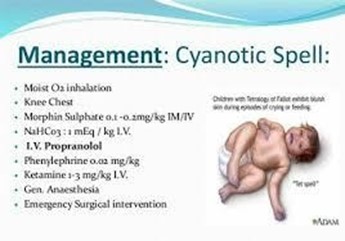A nurse is caring for an infant who has tetralogy of Fallot. The infant is crying and is experiencing a hypercyanotic spell. Which of the following actions should the nurse take first?
Administer morphine subcutaneously.
Apply a face mask supplying 100% oxygen.
Attempt to calm and soothe the child.
Place the infant in a knee-chest position.
The Correct Answer is B
Choice A rationale:
Morphine subcutaneously can help reduce anxiety and stress, but supplying oxygen is the priority intervention.
Choice B rationale:
During a hypercyanotic spell ("tet spell"), the infant's oxygen levels drop, leading to cyanosis (blue skin) and distress. Administering oxygen can help improve oxygen saturation and alleviate the spell.
Choice C rationale:
Calming and soothing the child may not be sufficient to address the oxygen saturation issue during a hypercyanotic spell.
Choice D rationale:
Placing the infant in a knee-chest position can help improve blood flow, but administering oxygen should be the initial step.

Nursing Test Bank
Naxlex Comprehensive Predictor Exams
Related Questions
Correct Answer is B
Explanation
Choice A rationale:
Using a disposable adhesive probe when measuring the client's SaO2 is not an intervention that can reduce the exposure of the client to latex, because adhesive probes may contain latex and cause skin reactions. A better option would be to use a non-adhesive probe or a probe cover that is latex-free.
Choice B rationale:
Rationale: Latex sensitivity or allergy can lead to adverse reactions when exposed to latex- containing products, such as blood pressure cuffs. Wrapping the blood pressure cuff in a stockinette helps minimize direct contact between the cuff and the client's skin.
Choice C rationale:
Silicone products are usually considered safe for individuals with latex sensitivity because silicone is a different material. Silicone products are generally safe for clients who are sensitive to latex, unless they have a separate allergy to silicone.
Choice D rationale:
Cleaning vial stoppers for 15 seconds before using them to withdraw-medications for the client is not an intervention that can reduce the exposure of the client to latex, because vial stoppers may be made of latex or rubber and cleaning them does not remove the allergen. A better option would be to use vials that have latex-free stoppers or to avoid puncturing the stoppers with needles.
Correct Answer is C
Explanation
Choice A rationale:
Chlamydia is a bacterial infection, so it is treated with antibiotics, not antiviral medications.
Choice B rationale:
Clients should abstain from sexual intercourse until the treatment course is completed to prevent transmission.
Choice C rationale:
Chlamydia infections are often asymptomatic in both males and females, which can lead to undiagnosed and untreated infections. Routine screening is important to detect and treat infections early.
Choice D rationale:
The recommended frequency for chlamydia screening in female clients at risk is annually, not every 2 years.
Whether you are a student looking to ace your exams or a practicing nurse seeking to enhance your expertise , our nursing education contents will empower you with the confidence and competence to make a difference in the lives of patients and become a respected leader in the healthcare field.
Visit Naxlex, invest in your future and unlock endless possibilities with our unparalleled nursing education contents today
Report Wrong Answer on the Current Question
Do you disagree with the answer? If yes, what is your expected answer? Explain.
Kindly be descriptive with the issue you are facing.
